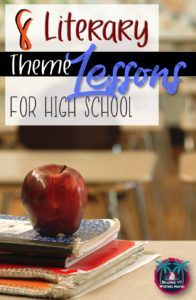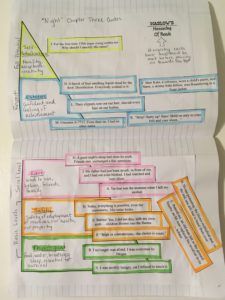8 Literary Themes and Lessons for High School
Teaching literature in a high school English class? Themes are, no doubt, an important component of any literary study. When English teachers select stories for our curriculums, we should take into consideration how the overall messages of the texts we choose impact our students. Young adult literature is brimming with character-shaping literary themes we can analyze with teenagers.
Let’s explore a solid list of themes worth teaching in high school classrooms as eight experienced English teachers share how they approach them in meaningful ways. Within these lesson plan ideas, you’ll find a mixture of classic and contemporary texts – covering a wide span of reading levels – that can effectively be used as vehicles for these weighty themes. Read about the first four in this post, and then jump to the second post to be inspired by the rest.
PREJUDICE
Reading & Writing Haven shares a lesson for teaching students about prejudice using To Kill a Mockingbird.
Many young adult novels deal with themes of racism, discrimination, and prejudice because these issues have historically been so prevalent in our society. To a degree, they haven’t gone away. One of the best ways teachers can affect change is by helping students view others with compassion and love instead of prejudice and hate. In my freshman English classroom, I use To Kill a Mockingbird as the vehicle to study this theme.
Before we begin, we always have a discussion about prejudice. I write the word in the middle of a web, and I ask students: What do you know about this word? As students begin to contribute ideas, I write them down…each idea branching off of another. Upon finishing, we watch The Sneetches and analyze some questions that provide a thematic foundation, which is a perfect framing activity for To Kill a Mockingbird.
Even though this cartoon might at first appear elementary, the symbolism and message get to the heart of many serious issues in the world today. While simple in design, this lesson always provides a platform for a rich, meaningful discussion.
EMPATHY
Read about how Doc Cop uses critical reading units to teach empathy.
Empathy requires the epitome of higher-order thinking: the ability to create an alternative reality to see life from someone else’s perspective. Teaching empathy as a theme, therefore, can be a challenge. The way I approach this theme in my classroom is through perspective-taking practices. When students learn multiple perspectives, they begin the journey to apply those perspectives to new contexts leading to empathetic views and self-reflection. Critical reading is closely connected to this type of higher-order thinking and perspective-taking. Therefore, I use multiple perspectives, also known as a literary theory or lenses, to study literature.
One of my favorite resources to apply multiple perspectives to literature is my Critical Reader’s Complete Novel Study. This multiple perspectives resource can be used with any book to give students the tools to build perspective-taking skills and garner empathy. Sound interesting? Read more about critical reading and download a free guide to get started.
AMERICAN IDENTITY
OCBeachTeacher has the perfect American literature unit to help students own their identities.
How does being American influence one’s identity? As a teacher of American Literature, I love starting the semester with my unit which introduces students to American voices and ideals through poetry, music, and art. It exposes students to diverse American authors such as Barbara Kingsolver, Walt Whitman, and Langston Hughes. Though these authors are from different time periods, races, and genders, they all create speakers who are greatly influenced by their country and its traditions.
This unit gets students thinking about who they are as individuals and as Americans. In a culminating assignment, “Name Yourself, Sing Yourself, or Proclaim Yourself,” students create self-portraits and write poems about themselves; it gives me and their classmates an opportunity to know them better. Moreover, it sets high expectations for close reading and literary analysis while also encouraging creativity.
OPPRESSION
Engaging and Effective has unique suggestions for using Night to teach students about oppression.
Unfortunately, oppression still happens in various forms around world; one of the ways to help prevent the spread and occurrence of oppression is to understand how and why it happens. This lesson was created for the novel Night – a memoir about a Jewish teenage boy’s experiences during the Holocaust. Towards the beginning of my Night unit, I include a lesson on Maslow’s Hierarchy of Needs to help students understand how the Nazi’s maintained control at the concentration camps by oppressing their victims.
First, I go over what motivates people and how they move up and down through the different levels of Maslow’s pyramid. We discuss how the first chapter of the book includes different examples of oppression coming from the Nazis, and how these forms of oppression resulted in lost levels on Maslow’s pyramid.
I then have students closely read the first half of chapter three of Night. This is where Elie and his family are processed at Auschwitz. The students use different colored highlighters to identify instances of oppression that ultimately take away different levels of the hierarchy pyramid: the hair cutting and uniforms takes away their esteem, the killing of babies takes away their sense of safety, and the separation of family takes away their sense of belonging.
By the time the first day at the camp is over, Elie explains: “We no longer clung to anything. The instincts of self-preservation, of self-defense, of pride, had all deserted us.” Since the students have identified quotes showing how each level is taken from Elie, they can now understand how the only thing that motivates Elie is food and a desire to not be separated from his father. This also helps later in the book as we see Elie and other sons begin to break under the oppression they’re enduring and turn on their own fathers. When my students get to the end where Elie does not go to his dying father, they really understand how oppression changed him to react this way.
Take me to the next four themes and accompanying lesson plan ideas for high school ELA!


